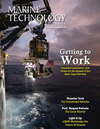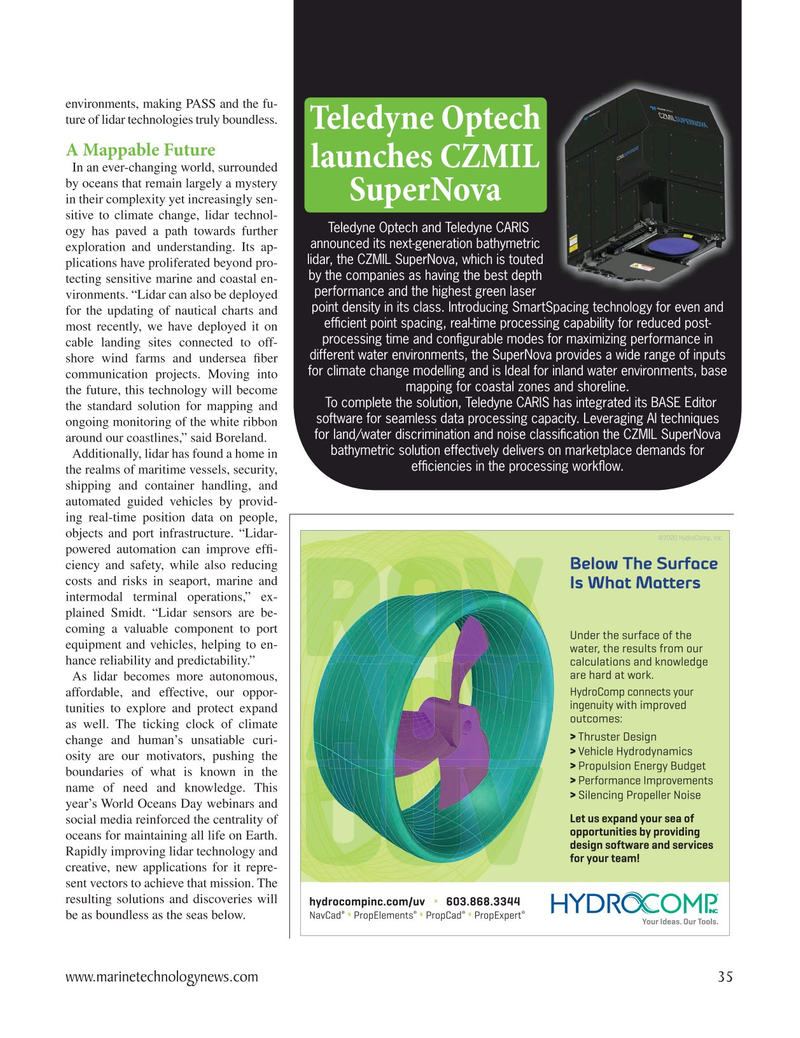
Page 35: of Marine Technology Magazine (July 2021)
Autonomous Vehicle Operations
Read this page in Pdf, Flash or Html5 edition of July 2021 Marine Technology Magazine
environments, making PASS and the fu- ture of lidar technologies truly boundless.
Teledyne Optech
A Mappable Future launches CZMIL
In an ever-changing world, surrounded by oceans that remain largely a mystery
SuperNova in their complexity yet increasingly sen- sitive to climate change, lidar technol-
Teledyne Optech and Teledyne CARIS ogy has paved a path towards further announced its next-generation bathymetric exploration and understanding. Its ap- lidar, the CZMIL SuperNova, which is touted plications have proliferated beyond pro- by the companies as having the best depth tecting sensitive marine and coastal en- performance and the highest green laser vironments. “Lidar can also be deployed point density in its class. Introducing SmartSpacing technology for even and for the updating of nautical charts and ef? cient point spacing, real-time processing capability for reduced post- most recently, we have deployed it on processing time and con? gurable modes for maximizing performance in cable landing sites connected to off- different water environments, the SuperNova provides a wide range of inputs shore wind farms and undersea ? ber for climate change modelling and is Ideal for inland water environments, base communication projects. Moving into mapping for coastal zones and shoreline.
the future, this technology will become
To complete the solution, Teledyne CARIS has integrated its BASE Editor the standard solution for mapping and software for seamless data processing capacity. Leveraging AI techniques ongoing monitoring of the white ribbon for land/water discrimination and noise classi? cation the CZMIL SuperNova around our coastlines,” said Boreland. bathymetric solution effectively delivers on marketplace demands for
Additionally, lidar has found a home in ef? ciencies in the processing work? ow.
the realms of maritime vessels, security, shipping and container handling, and automated guided vehicles by provid- ing real-time position data on people, objects and port infrastructure. “Lidar- ©2020 HydroComp, Inc.
powered automation can improve ef? - ciency and safety, while also reducing
Below The Surface costs and risks in seaport, marine and
Is What Matters intermodal terminal operations,” ex- plained Smidt. “Lidar sensors are be- coming a valuable component to port
Under the surface of the equipment and vehicles, helping to en- water, the results from our
R VR VROVU AU OV hance reliability and predictability.” calculations and knowledge are hard at work.
As lidar becomes more autonomous,
HydroComp connects your affordable, and effective, our oppor- ingenuity with improved tunities to explore and protect expand outcomes: as well. The ticking clock of climate > Thruster Design change and human’s unsatiable curi- > Vehicle Hydrodynamics
U U VU VU V osity are our motivators, pushing the > Propulsion Energy Budget boundaries of what is known in the >
Performance Improvements name of need and knowledge. This > Silencing Propeller Noise year’s World Oceans Day webinars and
Let us expand your sea of social media reinforced the centrality of opportunities by providing oceans for maintaining all life on Earth. design software and services
Rapidly improving lidar technology and for your team! creative, new applications for it repre- sent vectors to achieve that mission. The resulting solutions and discoveries will hydrocompinc.com/uv 603.868.3344L ® ® ® ®
NavCad PropElements PropCad PropExpertL L L be as boundless as the seas below.
Your Ideas. Our Tools.
www.marinetechnologynews.com 35
MTR #5 (34-49).indd 35 7/30/2021 10:58:01 AM

 34
34

 36
36
